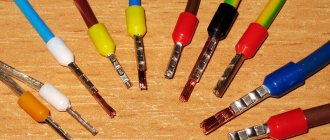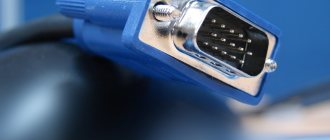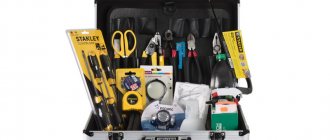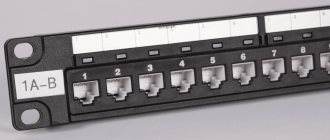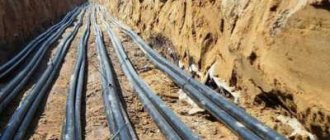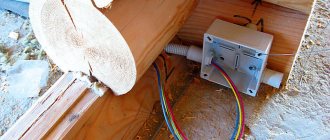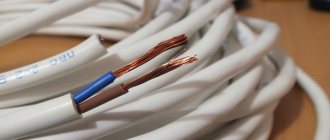Particular attention should be paid to the correct selection and professional installation of power, control, communication, and control cables in an explosive zone, since the uninterrupted supply of power to equipment, as well as the timely receipt of the necessary information, depends on this. The concept of an explosive zone is defined in GOST 51330.9-99, as well as in the Rules for the operation of electrical installations. The PUE identifies 6 zones (BI, B-Ia/b/g, B-II and B-IIa), which differ in the concentration of an explosive mixture in a time period in rooms or near hazardous objects in operating mode, as well as upon the occurrence of certain events ( accidents, leaks, etc.)
The class (type) of an explosive zone and the requirements for equipment protection determined for it, in many ways, determine the specific technical parameters of the cable, for example, its type and cross-section, which are necessary for the safe and continuous operation of machines and equipment.
Cable for hazardous areas - brand overview, laying features
The high probability of an explosion in a certain environment or space dictates increased safety requirements, including for cable lines.
The selection of brands and cross-sections of cables for hazardous areas, installation of cable products in lines and networks, connection of electrical machines, mechanisms, instruments and equipment must be carried out in strict accordance with the relevant rules (PUE) and GOSTs.
To solve problems rationally, explosive zones are classified depending on the presence of a gas mixture in the air, as well as the likelihood and extent of its spread. The classification of explosive zones according to GOST 51330.9-99 and according to the PUE differ slightly in that the Rules for the operation of electrical installations identify a larger number of such zones. More detailed information on zones can be found in the relevant regulatory documents.
Cable requirements for hazardous areas
The main regulatory requirements for cables that are operated in hazardous areas by GOST 51330.9-99 and PUE are as follows:
- It is strictly prohibited to use conductors that do not have an insulating layer, or with a protective sheath or polyethylene insulation.
- Brands of cables that are operated in explosive areas of any type can be equipped with an insulating and outer covering made of rubber or PVC polymer. Products in paper insulation are used exclusively in metal shells,
- cable products with copper conductors are allowed for installation in zones of types B-I and B-Ia according to the PUE, with aluminum - in zones of other types,
- protection against short circuits and overloads is mandatory, regardless of the electrical power of the receiver, for cables of lighting, power and secondary circuits up to 1 kV (V-I, V-Ia, V-II and V-IIa),
- conductor cross-sections cannot be less than the values allowed for the calculated electric current,
- The markings of cables in explosive zones of types V-Ib and V-Ig are protected in the same way as for products connected to non-explosive installations,
- For neutral protective and working conductors, it is necessary to have an insulating layer similar to conductors with phases.
Filled cable for hazardous areas
According to the requirements of GOST 51330.9-99 and PUE, the design of cables used in hazardous areas must not contain air cavities that exist between the elements of the products. The internal filling of cables for hazardous areas with a special polymer material ensures guaranteed non-propagation of gas/dust explosives through longitudinal air gaps from rooms and areas with a high probability of explosions to non-explosive ones.
For explosive areas, it is preferable to use armored cables, the reliable protective cover of which can withstand significant loads, ensuring the uninterrupted functioning of power systems. Cable products without armor protection can also be laid in such areas (in B-Ia/b/g, B-IIa), including in open space, but only in steel pipes.
Brief overview of cable brands for hazardous areas
The VBBShV brand and its variety, the KVBBShV control cable, are cable products that are recommended for use in all types of explosive zones. Armor made from a pair of steel or galvanized strips allows the product to be mounted at any industrial facilities, nuclear power plants, metro and other underground tunnels, in rooms, laboratories, tanks with gas tanks, overpasses for draining/filling flammable liquids, in special channels, in the ground, as well as in the open space.
Go to catalog
The KPGN brand, a type of CPG, is a flexible oil and petrol resistant cable for explosive areas, which allows you to connect mobile electrical mechanisms and equipment to networks with a rated electrical voltage of 0.66-1 kV. The KPGN brand can be installed in zones of type BI, as well as other types of explosive zones, in open space/indoors, on land and in water. recommended for use in other classes, without taking into account installation features, in water/on land.
Installation features
During installation, it is important to follow the installation rules:
- It is advisable to minimize the number of pipe turns, since each angle complicates cable pulling.
- At network nodes - turns, branches and places where electrical appliances are connected - distribution and wiring boxes are installed. This will simplify cable pulling after pipeline assembly and maintenance of the electrical network during operation.
- To pull electrical cables, a steel string is used: first, it is pulled through the resulting cable channel, the string is connected to the cable and pulled out from the opposite side. Thus, cables are gradually laid throughout the pipeline and the sections of wires in boxes are connected, forming a single electrical network.
- Plastic bushings are fixed at the ends of the pipes, the purpose of which is to prevent chafing of the cable braid.
- It is better to connect pipes using threaded fittings - special connecting elements, and not by welding. This will simplify installation and further repairs.
- The pipeline is secured using clamps and brackets, the distance between which depends on the internal diameter of the pipes.
| Pipe internal diameter, mm | Distance between fastening elements no more than, m |
| 15-20 | 2,5 |
| 25-32 | 3 |
| 40-80 | 4 |
| 100 | 6 |
- Boxes - distribution and traction - are placed at such a distance to ensure ease of pulling cables and simplify their replacement in the future. This distance depends on the number of turns of the electrical cable.
We recommend that you read: Stainless steel air ducts for ventilation installations
| Number of corners | Distance between boxes no more, m |
| 1 | 50 |
| 2 | 40 |
| 3 | 20 |
- If it is necessary to rotate the cable more than 90 degrees, an additional cable duct will have to be installed at the turning point. Otherwise, when pulling the electric cable, it will be caught in the bend of the pipe and it will not be possible to pull it out.
Wiring in explosive areas
» Electrical wiring » Electrical wiring installation » Wiring in hazardous areas
- 1 Basic requirements for the cable
- 2 Methods for laying a cable line
Wiring in explosive areas must be carried out using a special cable, as well as in strict compliance with all norms and requirements of GOST, SNiP, and PUE. Thanks to this, you will be able to secure your premises in the future.
In this article, we tried to tell you how cables are laid in hazardous areas and what requirements must be met for installation.
Basic cable requirements
At the moment, an explosive facility requires the use of a special cable during wiring. The danger zone can have a variety of classes, but the conductor must have a certain sheath:
- Paper and rubber insulation.
- Polyvinyl chloride and rubber insulation.
- Rubber and lead sheath.
Explosion-proof scales
- Certificates
manager
- Description
- Specifications
- Level of protection of scales and markings
Explosion-proof automobile, platform, conveyor and railway scales from the Weighing Equipment Plant
At production, processing and storage sites of hazardous substances there is a high risk of accidents. The equipment of such enterprises, including weighing equipment, is subject to special safety requirements.
Weigh chemicals, toxic substances, petroleum products and gases using explosion-proof equipment.
Explosive and fire hazardous substances are transported by rail, road, air and sea. Loads are weighed on special explosion-proof scales. Protection in them is provided by an electrical network protected from sparks.
Explosion-proof truck and railway scales can have the largest measurement limit of up to 200 tons. Trains are weighed:
- loaded and empty train;
- cars without stopping movement, without uncoupling the train;
- wagons in the process of loading (in doses).
Modern explosion-proof scales are certified without fail. The correct choice of weighing equipment will save material assets and human lives.
Purpose of explosion-proof scales
Electrical equipment accumulates electrostatic voltage. It poses a potential hazard in an explosive environment. Scales, even with reliable grounding, belong to this class of electrical equipment. Therefore, flammable, combustible substances and gases capable of spontaneous combustion are weighed using explosion-proof scales.
buy explosion-proof scales by calling the phone number, writing to us by e-mail: [email protected] or by clicking on the “Order” and filling out the order form
Technical characteristics of explosion-proof scales
Weighing equipment for weighing and dosing materials can be simple and explosion-proof.
Operational safety is ensured by:
- Spark protection cabinet. It houses various spark extinguishing barrier modules. When it is snapped onto the DIN rail, the protective ground is automatically switched on. This explosion-proof equipment is used in the oil and chemical industries.
- Strain gauges.
- Cable distribution is laid in metal pipes.
Cable for hazardous areas - type of grades, cable requirements
Organizing a workspace in an environment with a potential explosion hazard is a complex and responsible task that requires highly qualified specialists and compliance with the strict conditions of regulatory documents.
Particular attention should be paid to the correct selection and professional installation of power, control, communication, and control cables in an explosive zone, since the uninterrupted supply of power to equipment, as well as the timely receipt of the necessary information, depends on this.
The concept of an explosive zone is defined in GOST 51330.9-99, as well as in the Rules for the operation of electrical installations. The PUE identifies 6 zones (BI, B-Ia/b/g, B-II and B-IIa), which differ in the concentration of an explosive mixture in a time period in rooms or near hazardous objects in operating mode, as well as upon the occurrence of certain events ( accidents, leaks, etc.)
Methods for laying a cable line
How to lay cables in explosive areas? There are several options for laying and these options are recommended by the PUE. For example, in electrical networks with voltages up to 1 kV, a separate cable core is used for grounding or grounding. In this case, the armor (metal sheath) of the cable is grounded on both sides (at the beginning and end of the line), according to Chapter 2.3. PUE clauses 2.3.71, 72, as well as chapter 1.7, for example clauses 1.7.97, 98 and a number of others from these chapters.
At explosive objects in which the danger zone belongs to classes B1 and B1a, the cable line is laid in pipes, which, in turn, are located in the wall. The end of the pipe is processed and sealed with special pipe seals.
Installation of electrical wiring in the place where an explosive object passes into a normal room is carried out as follows: pipe seals are installed on the side of the room where the explosion hazard zone has a high class. If the installation is carried out between rooms where the explosive class is the same, then the pipe seals must be placed in the building where mixtures of a higher category are located. If the hazard class is B1, then the seals should be placed on both sides of the passage.
It is important to know! The cable line that needs to be laid through the ceilings must extend 0.15 meters from the floor surface.
In order to protect the cable from various mechanical or chemical damage, it is placed in metal pipes. In the pipe, the cable line is under reliable protection. With the help of cast iron boxes, type B (so-called fittings), which are sufficiently protected from explosions, cable lines are connected and branched. The photo below shows the appearance of the explosion-proof box:
If the installation is carried out in a room with high dampness, then the cable is laid with a certain slope towards the broaching and junction boxes. If the area where it is necessary to lay the cable is excessively damp, then the wiring is laid in the direction of the drainage pipe. If the room is dry, then this installation method is not needed, but if condensation is possible, then you should make a slope in the direction where it is expected to fall out.
A dangerous zone implies a different class of object, which determines the method by which the cable can be laid. If the circuit is intrinsically safe, then the installation can be carried out both open and closed. If the explosive object belongs to class B2, then laying is carried out using special trays. In addition, it should be remembered that if the wiring is armored, then it is necessary to use structures with narrow horizontal surfaces. They are also placed on edge and the distance to the wall should be 20 millimeters.
It is important to know! All these measures are necessary in order to protect the premises from the possible appearance of explosive dust, which is quite difficult to remove.
The cable must be laid in an explosive atmosphere so that the wiring is not damaged. In addition, it is necessary that the cable lines themselves are sealed and well protected from explosions, because conductors can be sources of ignition of flammable substances. The area where flammable substances are located is considered explosive and one spark is enough to start a fire. That is why existing safety rules and requirements should be strictly observed and adhered to. If all requirements are met and the rules are followed, then the occurrence of an emergency is minimized.
So we looked at how cable laying should be done in explosive areas. For a more detailed consideration of the issue, we recommend studying such regulatory documents as the PUE (Chapter 7.3) and GOST R 51330.13-99 (IEC).
What types of pipes are best to use?
Various types of pipes can be used for laying wires:
- round suture or seamless,
- profile rectangular or square,
- galvanized (with a cross section of any shape),
- plastic (polyethylene, HDPE).
For most cases, the best option would be to use a galvanized steel profile pipe. Due to its geometry, it provides the best protection against unintentional squeezing or bending of the line, and the zinc layer improves corrosion resistance when used in aggressive environments. At the same time, the absence of a seam does not in any way affect the performance characteristics, but increases the price.
The only situation where steel is inferior to plastic is when laying wires and cables in pipes underground, since polyethylene is much more resistant to direct contact with soil and water. However, it will not save you from mechanical damage - even a blow with an ordinary shovel when digging a line or carrying out other work can damage not only the protection, but also the cable system itself. In this situation, it is necessary to assess the likelihood of damage and select the most reliable product yourself.

